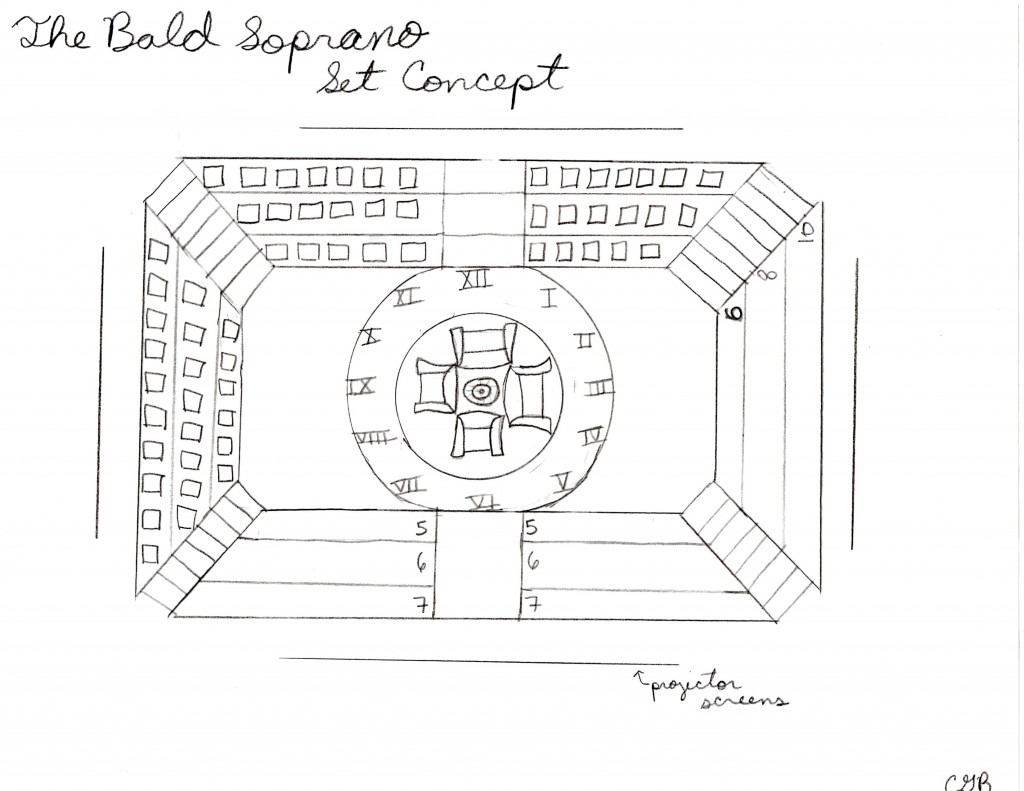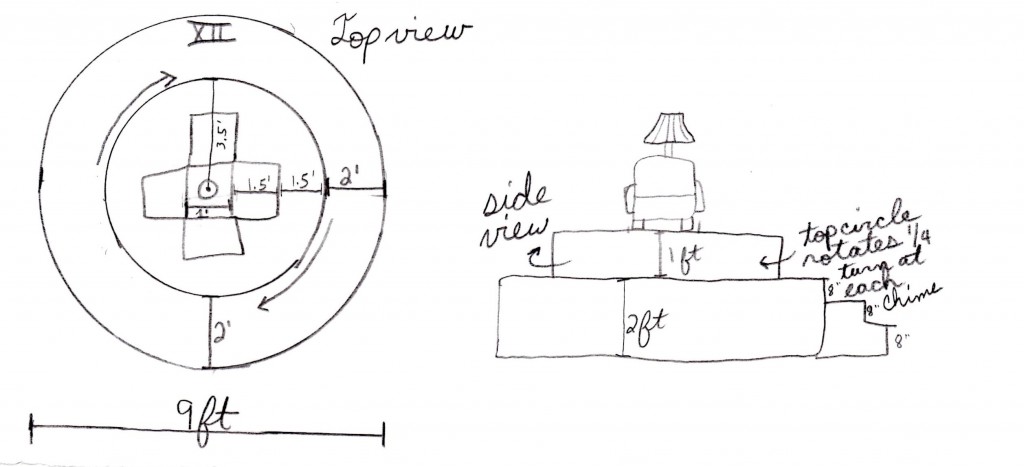The Bald Soprano’s message of the ultimate futility and breakdown of language and communication is just as relevant in a modern setting as it was in 1950 when the play first premiered. The fears over the mechanisation of language have since manifested themselves as the modern world’s increasing dependence on technology and the internet to communicate. This is then compounded by the lack of substance and meaning that the vast majority of these communications contain. The fear that language has become vapid and meaningless in the face of the various social media platforms that now poorly mimic face to face interaction is a valid one. This proposed production of The Bald Soprano is meant not to shame technology and social media as the root of society’s communication problems, but rather to make the audience aware of how large of a presence it plays in their day to day communications and encourage face to face discussion of its implications.
The first and most major adaption to modern society in this production would be that all actors instead of interacting each other, would instead be interacting with a smartphone or a laptop for the majority of the play and acting to the technology as if it were the character they were supposed to be talking to. I would suggest that Mrs. Smith and both of the Martins be equipped with smartphones while Mr. Smith would have a laptop as throughout the beginning of the piece in the original he is engrossed in a newspaper and a laptop is much larger than a smartphone and would more easily be read as total engrossment and provides a much larger surface to partially hide behind as the newspaper in the original would have allowed. This would continue until after the exit of the Fire Chief when the phones would be put away, yet, to the distress of the Martins and Smiths, despite spending an entire evening together they are unable to understand each other or hold a meaningful conversation without the aid of their devices. The end of the play would see the same cycle that Ionesco wrote and would bring with it the undertones of the cycle that meaningless language and interaction will continue so long as social media remains the method for the vast majority of social interactions.
Another major proposed change is that the characters of the Maid and the Fire Chief would not have physical characters on the stage. Instead the Fire Chief would appear on the projector screens as a series of social media updates and conversations that would, presumably, also be happening on the character’s phones as well. These “updates” would also be read aloud offstage or have been pre-recorded in order to maintain the audio component and ensure that all the lines still reached the audience, regardless of the speed of their reading. The Maid, in contrast, would be a solely auditory character and would take on the guise of a technological personal assistant similar to Siri or Cortana as both of these services are a similar modern equivalent to what could be considered the maids of the 21st century. The Maid also serves as a pseudo-narrator at key points of the play and enlightens the audience to important information as well, thereby lending herself to the idea that she could be a very Siri-like character. Both the Fire Chief and the Maid being non-physical characters also underlines the breakdown of meaningful communication in the face of technology as now 1/3 of the characters presented in the piece exist purely as two more members in a much larger network that social media creates and thereby underlines the effects that even those whose only presence is via technology can still have significant bearing on the behaviors exhibited by those they communicate with.
 As the set concept suggests, for the majority of the piece the characters would not even be facing each other, rather each one would face out to their own section of audience. This idea further underlines that despite the four character sharing the same space, they still make the choice to communicate via their device instead of turning to their neighbor to speak. The anecdote of people sitting in the same room but yet only texting each other to communicate is meant to be brought to the forefront of the audience’s minds and is the main inspiration of the design. Each of the couples should be directly opposite each other so that it is not possible for them to see each other during the scenes with the individual couples and furthers the idea that they couldn’t possibly be directly talking to each other. The armchairs and the lamp placed at the centre of the clock face should not be modern, but rather give the idea of a very traditional English sitting room. The idea is that the room and the technology should be at odds with each other, and therefore in conversation as the modern way of life and communication is slowly overtaking the traditional one.
As the set concept suggests, for the majority of the piece the characters would not even be facing each other, rather each one would face out to their own section of audience. This idea further underlines that despite the four character sharing the same space, they still make the choice to communicate via their device instead of turning to their neighbor to speak. The anecdote of people sitting in the same room but yet only texting each other to communicate is meant to be brought to the forefront of the audience’s minds and is the main inspiration of the design. Each of the couples should be directly opposite each other so that it is not possible for them to see each other during the scenes with the individual couples and furthers the idea that they couldn’t possibly be directly talking to each other. The armchairs and the lamp placed at the centre of the clock face should not be modern, but rather give the idea of a very traditional English sitting room. The idea is that the room and the technology should be at odds with each other, and therefore in conversation as the modern way of life and communication is slowly overtaking the traditional one.
This production would ideally take place in the round and have each of the four physical characters facing ¼ of the audience at any given time and never each other until the after the final words of the Fire Chief. The set itself would consist of two concentric circles with the outermost circle resembling the clock face of the antique grandfather clock whose chimes are heard throughout the play. The inner circle would be raised off the clock face and would hold the four chairs of the sitting room. Since the actors are static for the majority of the piece this inner circle would rotate a quarter turn at each chime of the clock and thereby allow each section of the audience the opportunity to more closely interact with each character. 
The four projector screens would be hung directly over the last row of the audience on each side and would contain the “status updates” of the Fire Chief and perhaps other key pieces of dialogue or moments projected onto them. This would create an almost double-vision with the audience as they are forced to pay attention to the scene occurring onstage and projection screen. This feeling would emulate the modern tendency for people to both attempt to participate in the physical world around them and pay attention to their devices.
After the final lines of the Fire Chief, when the character’s devices are no longer in use and they realise they have all been in the same room the entire time, there should be a flurry of activity as characters try to gain some distance from each other and find a new medium of communication now that their devices have died on them. As the characters become more frustrated they should remove themselves from the sitting room area of the set and spread themselves out throughout the theatre and into the aisles and generally in the audience’s space. These failures at face to face communication that take the form of a series of non-sequiturs should not be directed at each other but rather at various audience members as the characters have no idea how to communicate with each other and instead of using their devices as a medium to communicate have moved on to the using the audience as a conduit of what they wich to say to each other. The words aimed at the audience, however, fail to allow communication and neither the audience nor the characters are able to establish any form of understood and meaningful conversation. This final series of nonsensical truisms should contain a large amount movement in and amoungst the aisles and audience that have been purposefully kept clear to further highlight the lack of previous movement. The action should then draw back to the clock face as the final lines are spoken and at the blackout the Smiths should disappear as the Martins begin the play anew with the understanding that this cycle will be just a meaningless as the first as the couples are still more focused on their technology than on their interactions with each other.
The audience is kept purposefully small, as The Bald Soprano is a piece that can have the greatest impact when the audience is small. In the set concept, the audience is capped at 112, and 100 or less would certainly be ideal as this would also allow a larger proportion of audience members to be directly interacted with during the final scene. This failure of face to face communication is more effective when experienced directly and a larger audience finds more of the audience alienated from this experience. The smaller audience being placed in the round also puts them all in view of each other and creates a sense of camaraderie between members as they have all been put in view of each other.
The idea for the costumes of this adaptation is that they should be modern, and thereby also in conversation with the traditional set that is being overtaken by the ever forward march of the modern era. Despite this, parts of the costumes should be “traditional” and dated to a similar time as the sitting room.
This could be accomplished by perhaps a waistcoat over a t-shirt, a smoking robe worn with jeans, or a pill box hat paired with a modern blouse and pants.The cyclicity of the ending should not only be kept, but expanded further than just a few lines the script suggests. One ending point could possibly be a slow fade at the Maid’s first line, but instead of the voice of Siri, a different technological personal assistant should be used so as to not call out any company or service in particular, but rather show how all of the devices have the same effect. In the same vein, the devices used by the four characters should not be all of one company or model, but rather a mixture so as to avoid the misinterpretation of one particular company being at fault for to falling apart of modern communication. Rather it should be seen that it is not only the technology companies contributing to the problem, but the people using the devices as well.




